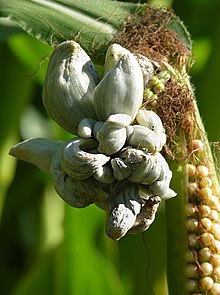Corn smut
| Corn smut | |
|---|---|

| |
| Ustilago maydis diploid teleospores | |
| Scientific classification | |
| Domain: | Eukaryota |
| Kingdom: | Fungi |
| Division: | Basidiomycota |
| Class: | Ustilaginomycetes |
| Order: | Ustilaginales |
| Family: | Ustilaginaceae |
| Genus: | Ustilago |
| Species: | U. maydis
|
| Binomial name | |
| Ustilago maydis | |
| Corn smut | |
|---|---|
 Huitlacoche | |
| Common names | huitlacoche (Mexico), blister smut of maize, boil smut of maize, common smut of maize, corn truffle[source?] |
| Causal agents | Ustilago maydis |
| Hosts | maize and teosinte |
| EPPO Code | USTIMA |
| Distribution | Worldwide, where corn is grown[2][3] |
Corn smut is a disease that affects corn, which is also called maize. The fungus Ustilago maydis causes corn smut.
Lumps of growing tissue called galls grow on the corn. They can grow on the ears, leaves or stalks. Corn is more likely to have corn smut if it has been cut by machines or hailstones.
Farmers can stop corn smut by using corn that has been bred to be strong against the fungus. They can also stop corn smut by crop rotation. This is because the fungus can wait in the soil over the winter for the next crop. If the corn is not in the same field each year, it is harder for corn smut to reach new corn plants.[4]
Corn smut is safe to eat, and chefs cook it.[5]
References[change | change source]
- ↑ Ustilago maydis in Index Fungorum
- ↑ "Common smut of corn". apsnet.org. American Phytopathological Society. Retrieved 2018-10-06.
- ↑ "Ustilago maydis (DC.) Corda". Global Biodiversity Information Facility. Retrieved 2018-10-06.
- ↑ "Common smut on corn". University of Minnesota Extension. Retrieved May 3, 2021.
- ↑ Jill Neimark (August 24, 2015). "Scourge No More: Chefs Invite Corn Fungus to the Plate". NPR.
